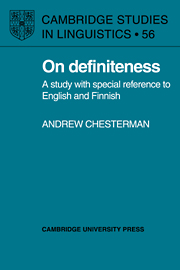Book contents
- Frontmatter
- Contents
- Acknowledgements
- 1 Introduction
- 2 English articles: the research traditions
- 3 English article usage
- 4 A unified description of the English articles
- 5 Finnish: no articles
- 6 Finnish spesies
- 7 The status of definiteness in Finnish
- 8 English and Finnish contrasted
- 9 Wider perspectives
- References
- Author index
- Subject index
1 - Introduction
Published online by Cambridge University Press: 18 September 2009
- Frontmatter
- Contents
- Acknowledgements
- 1 Introduction
- 2 English articles: the research traditions
- 3 English article usage
- 4 A unified description of the English articles
- 5 Finnish: no articles
- 6 Finnish spesies
- 7 The status of definiteness in Finnish
- 8 English and Finnish contrasted
- 9 Wider perspectives
- References
- Author index
- Subject index
Summary
The realization of definiteness
The general structure and purpose of this study is Popperian. The starting-point is neither a corpus of data nor a particular theoretical position, but a problem, or rather a set of problems. My basic strategy is first to describe the problems, then consider the solutions that have been proposed to date. I then try to show in what respects these solutions are inadequate, how they neglect or misinterpret certain kinds of data and finally suggest my own analysis. In Popper's terms I thus proceed from Problem to Hypothesis to Test to New Hypothesis (see Popper 1972). It then remains to be seen what new problems and further, more refined, hypotheses will follow from where this study leaves off.
The general issue is: what is definiteness? This is first of all a semantic, conceptual question: what does the term ‘definiteness’ mean? Consequently, and more specifically, we may ask: what does it mean to say that something is definite or indefinite?
A second level of discussion then has to do with recognition: given a definition of definiteness, definite and indefinite, how do we actually recognize that something is definite or not? This is a matter of realization, in two senses of the word.
- Type
- Chapter
- Information
- On DefinitenessA Study with Special Reference to English and Finnish, pp. 1 - 9Publisher: Cambridge University PressPrint publication year: 1991



